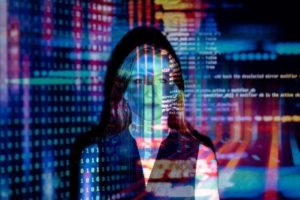Mandy Hathaway
Share:
Current artificial intelligence (AI) networks are generally created via machine learning. That is, computer systems are given massive datasets and taught to sift through that data in order to make predictions based on it. Through medical scan image recognition, current systems are beginning to outperform medical professionals at cancer diagnosis.
Nikolaos Papanikolopoulos stopped by Metropolitan State University’s St. Paul campus Tuesday, Oct. 29, to introduce his work to students in the Human Services Capstone class HSER 455. Papanikolopoulos, a professor at the University of Minnesota, has a doctorate in electrical and computer engineering and is the director of the Center for Distributed Robotics there.
His current projects focus on applying the sort of technology used to diagnose cancer to other medical diagnostics. “Symptoms are actually snapshots,” Papanikolopoulos said. His goal is to use AI to assist with mental health diagnoses by collecting and going through those snapshots.
He and his team have been working on using image and video recognition technology to help identify mental health classifications. By using Microsoft Kinects to monitor children at play, the team looks for a variety of physical behaviors associated with Autism Spectrum Disorder (ASD), such as hand flapping. By analyzing this data, they were able to correctly identify which children had been diagnosed by professionals as being on the spectrum.
Just this single task, once perfected, could free up hours of work for professionals. Currently, medical professionals often must pour over hours of recorded patient interviews, frame by frame, to identify and confirm such behaviors’ presence in order to make an accurate diagnosis.
Targeting behaviors typical of people with Obsessive-Compulsive Disorder, ASD and Tourette syndrome, Papanikolopoulos’s interdisciplinary team is dedicated to developing systems that can identify such behaviors in subjects.
While he worries that the current stigma around mental health diagnosis makes his work more challenging, he is dedicated to advancing these technologies. As Papanikolopoulos puts it, he and his team are “all about human well-being.”
This technology could be applied in a wide variety of ways. Papanikolopoulos envisions a future where telepsychiatry, aided by this image recognition software, could bring diagnosis and treatment to rural populations that are generally the least likely to have access to high-end medical professionals. This would allow for treatment without excessive travel and facilitate early interventions.
While finding funding hasn’t been as easy for his team as for those studying more mainstream cancer diagnostics, he feels confident that, in time, these technologies could help a huge number of individuals and the future of psychiatric medicine.




